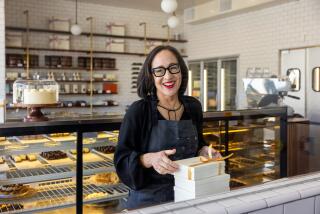Irresistible Emporiums
- Share via
I had heard that London would be costly but I had no idea, before strolling into the terra-cotta mountain of Harrods, that wild boar pate was selling for $9 U.S. a pound.
Yet that was about half the price of Harrods’ own truffles, the handmade chocolate ones dusted with cocoa, not the musty tubers rooted out of the earth by pigs and considered, by some, a delicacy.
For me, a visit to London is hardly complete without a walk through the bright and fresh Food Halls of Harrods, an establishment that began life as a grocery store in Knightsbridge in 1849 and is purveyor of everything from high-fashion frocks to grandmother clocks, from books to silks to jeans.
The food halls are galleries of art nouveau, of tile wall decorations and ornate ceilings with hunt scenes made by the Royal Doulton porcelain factory in Lambeth, which closed in 1910.
Counters are rich with cheeses and lamb, plum puddings and curries-to-go. Fajitas are a recent rage. Clerks in straw boaters, piped in Harrods’ green ribbon, take orders for goose and pheasant, for old grouse and young, for kippers and salmon.
Cameras and Jellybeans
Garlands of sausages deck the halls amid wreaths of bay leaves and garlic. A stuffed still life of peacocks glows like an opal against white tile walls in the same section. Flashes from tourists’ cameras add to the holiday spirit; clerks play along with smiles.
One alcove glitters with jellybeans in a rainbow of flavors: cantaloupe, coffee bean, cranberry, green apple, licorice, bubble gum, cinnamon, root beer, chocolate pudding, cream soda, blueberry, boysenberry, cotton candy, apricot, banana, pina colada, peanut butter, green watermelon, strawberry daiquiri, tangerine, grapefruit and butterscotch.
Jellybeans are not self-service; a lad in a boater, wearing plastic gloves, flicks your selection from glass bins into a Baggie. If a choice seems too tough, you can buy mixed flavors for less than the price of wild boar pate.
The rich aroma of espresso floats from counters in the food halls. I find it irresistible to stop for a sip and a taste of Stilton and biscuits. Dogs have been banned from Harrods since my last visit, when two runaway dachshunds entangled my legs in their leashes. Naturally the store provides a kennel where shoppers may check their pets.
Queen Victoria’s Choice
Yet for all that, Harrods--and the elegant Knightsbridge district itself--is a come-lately compared to the emporium of Fortnum & Mason in Piccadilly, which has been selling provisions to the Royal Family since 1707.
These merchants sent tongues and hams to Wellington’s officers and filled Queen Victoria’s order of beef tea concentrate for Florence Nightingale in the Crimea.
And now a clerk in morning coat and pin-stripe trousers, a man bathed in the light of crystal chandeliers, was offering to help me. He showed me First Flush, a Darjeeling tea so named because it’s the new season’s tea.
Then we talked honey. Fortnum & Mason offers lavender honey and heather honey, English flower honey and macadamia blossom honey. There is Tasmanian leatherwood honey, Mexican Yucatan honey, Canadian clover honey and two entries from Hungary: acacia honey and sunflower honey.
Feeling as wild as Winnie-the-Pooh, I moved on to marmalades. My man said that he fancies thick-cut Sir Nigel’s vintage marmalade, and prefers orange to grapefruit or lime. His uncle, he said, insists on Double Two from Wilkin & Sons of Tiptree in Essex, over their classic Double One.
“Double One runs when you pour it,” explained the clerk. “Double Two is thicker, more solidified.”
There is time for such talk in England.
Toffee by the Tin
I bought small gifts: a porcelain egg full of honey, and two tins of toffee with Pooh’s pals, Piglet and Eeyore, painted on top. I could not resist an empty lidded jar the color of Devonshire cream with the Fortnum & Mason crest in gilt. I wish that I had bought more.
Near the Piccadilly exit I wavered to examine the fresh fruits: exotic entries from Thailand and Malaysia, sweet ogen melons from Israel and, most boggling, a large yellow fruit splotched with brown. It resembled a bashed and bruised grapefruit, or last year’s soccer ball.
“Is it supposed to look like that?” I asked the fruit clerk.
“Oh yes,” he said earnestly, from beneath a red toupee that was almost straight. “It’s a rather new treat for us and very much the vogue. It has a thick rind and actually tastes more like an orange than a grapefruit. It’s called Ugli.”
The clerk leaned close and whispered. “They say it got its name because the Queen Mother was visiting in Jamaica and saw these fruits on the ground and said ‘My, how ugly.’ ”
Whether that is royal fact or royal rumor, I do not know. But if Queen Victoria sent around for beef tea concentrate, anything is possible.
More to Read
Eat your way across L.A.
Get our weekly Tasting Notes newsletter for reviews, news and more.
You may occasionally receive promotional content from the Los Angeles Times.










